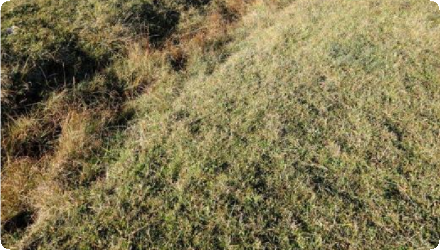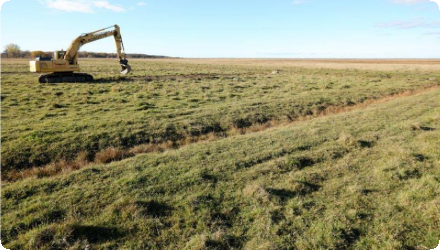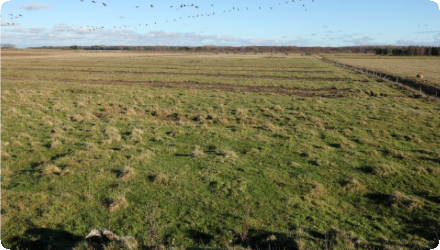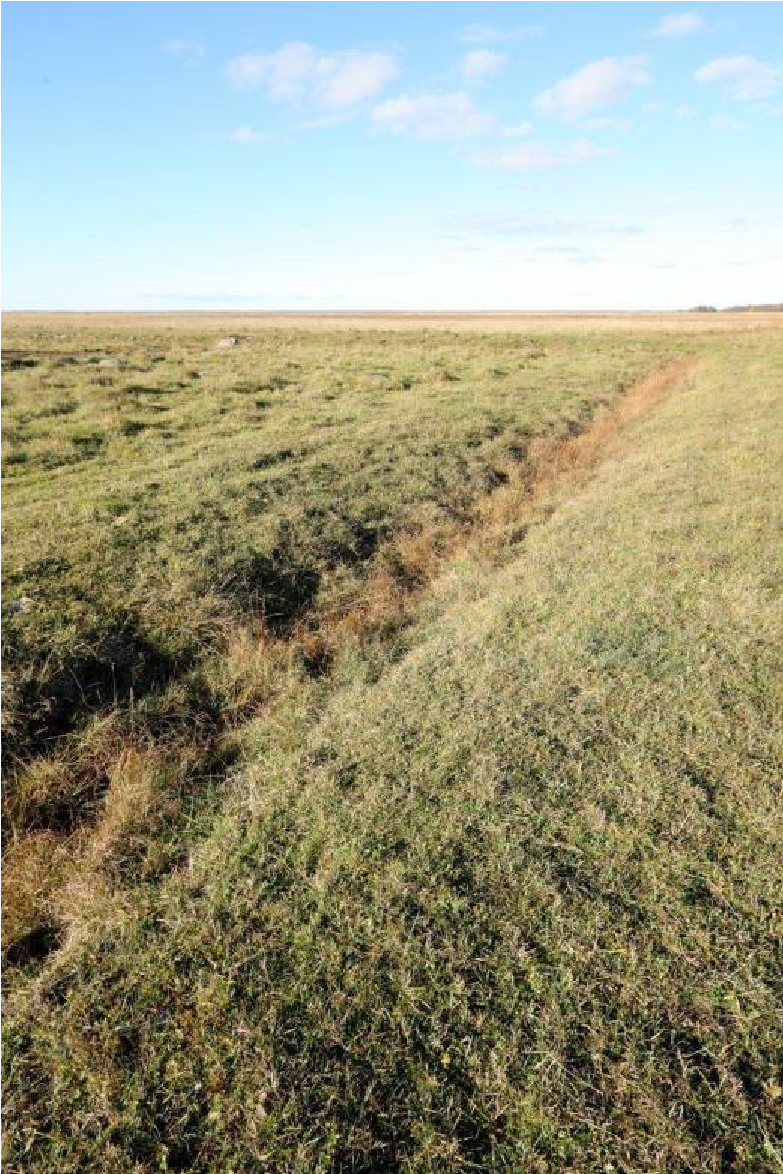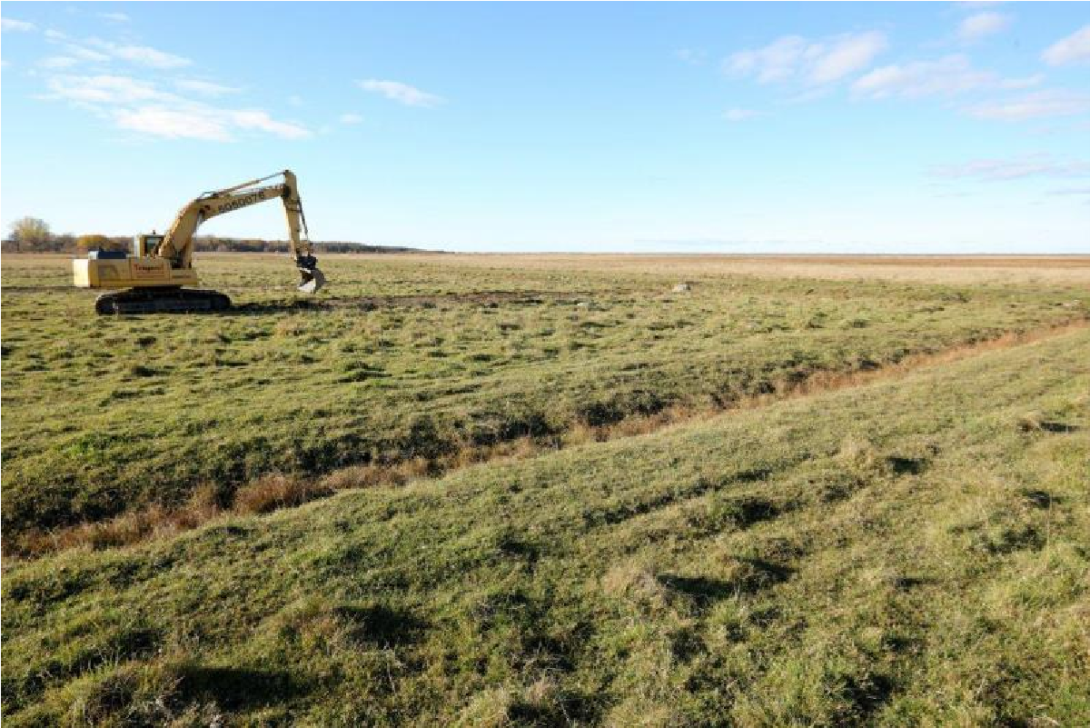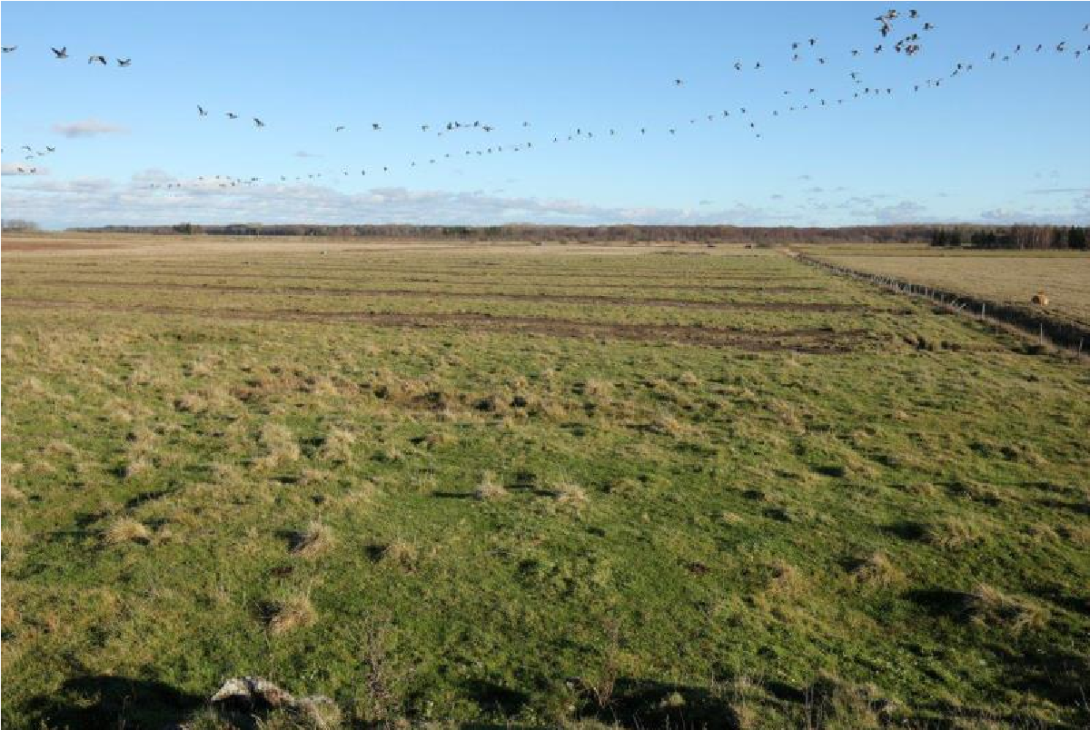Last update
2025
Summary
The measure was implemented in 2013 in Matsalu National Park (Natura 2000, Ramsar), at a former coastal meadow beside the large Salmi complex. Old, non-functioning field ditches were closed and scraped to restore wetland hydrology and breeding/feeding habitat for waders and amphibians. Grazing continued as before, with better access to drinking water for cattle.
Since then, the site has been managed as part of the wider Keemu–Salmi coastal meadow system (~360 ha) within a park that maintains ~3,000 ha of coastal meadows, among the largest in Europe. National guidance and the 2021–2027 Action Plan for semi-natural grasslands reinforce long-term maintenance (grazing/mowing, shrub control) and allow restoration actions such as closing drainage to keep meadows wet.
For fauna, Salmi–Keemu is a priority area for the natterjack toad; the species plan recommends sustaining sufficient grazing to keep short-sward habitat and preserving shallow, temporary pools created by micro-relief. In response to very high nest predation on coastal meadows, a pilot predator-control programme (2021–2024) was introduced at Keemu and Salmi to improve wader breeding outcomes.
Overall, the 2013 hydrological works are now embedded in park- and nation-wide management that keeps the meadows open and wet while targeting key bird and amphibian conservation needs.
The project was a rather small-scale restoration effort, which was originally intended to be expanded, but for various reasons this did not take place. No monitoring activities have been carried out to assess the effectiveness of the restoration.
Since then, the site has been managed as part of the wider Keemu–Salmi coastal meadow system (~360 ha) within a park that maintains ~3,000 ha of coastal meadows, among the largest in Europe. National guidance and the 2021–2027 Action Plan for semi-natural grasslands reinforce long-term maintenance (grazing/mowing, shrub control) and allow restoration actions such as closing drainage to keep meadows wet.
For fauna, Salmi–Keemu is a priority area for the natterjack toad; the species plan recommends sustaining sufficient grazing to keep short-sward habitat and preserving shallow, temporary pools created by micro-relief. In response to very high nest predation on coastal meadows, a pilot predator-control programme (2021–2024) was introduced at Keemu and Salmi to improve wader breeding outcomes.
Overall, the 2013 hydrological works are now embedded in park- and nation-wide management that keeps the meadows open and wet while targeting key bird and amphibian conservation needs.
The project was a rather small-scale restoration effort, which was originally intended to be expanded, but for various reasons this did not take place. No monitoring activities have been carried out to assess the effectiveness of the restoration.
Position
Latitude
58.7167
Longitude
23.6666
Project
NWRM
National Id
Estonia_01
Installation date
2013
Implementation Status
Contact
Sandra Oisalu, BEF Estonia
RBD code
EE1
Transboundary
0
Photo gallery
Location of the project
Salmi coastal meadow in western Estonia in Matsalu National Park (southern shore of Matsalu bay), rural coastal area, Natura 2000 and Ramsar site. The area of the Salmi coastal meadow is approximately 350 ha which makes it one of the largest complete coastal meadow massifs in whole Europe.
NUTS Code
EE00 - Eesti
Project's objectives
Restore the hydrological regime by closing and scraping old field ditches to slow drainage from the meadow to the sea; this was the primary design target (“regulation of hydrological cycle and water flow”).
Recreate breeding/feeding habitat for waders and amphibians (and other protected species)
Keep existing bovine grazing unchanged while improving access to drinking water for cattle as a co-benefit.
Pilot/validate a restoration method (inspired by UK practice) for potential replication on other Estonian coastal meadows affected by old drainage.
Ditches treated: 12 small ditches, totaling ~3.9 km of ditch network closed/scraped.
Recreate breeding/feeding habitat for waders and amphibians (and other protected species)
Keep existing bovine grazing unchanged while improving access to drinking water for cattle as a co-benefit.
Pilot/validate a restoration method (inspired by UK practice) for potential replication on other Estonian coastal meadows affected by old drainage.
Ditches treated: 12 small ditches, totaling ~3.9 km of ditch network closed/scraped.
Involved Partners
| Authority type | Authority name | Role | Comments |
|---|---|---|---|
Climate zone
cool temperate moist
Annual rainfall range
600 - 900 mm
Elevation range
11 m
Slope range
2-5%
Vegetation class
Habitat site of rare species - Platanthera bifolia, Dactylorhiza incarnata). At the moment in ditches - Lythrum salicaria, Carex vulpina, Schoenoplectus lacustris, Mentha aquatica, Alisma plantagoaquatica, Sparganium emersum.
Water bodies: Ecological Status
Good
Water bodies: Chemical Status
Failing to achieve good
Water quality status
The wetland had good quality water, chemical status is good. It is a Nature2000 site. No pollution has been marked. The aim was not to rise the quality of water but to restore the hydrological regime.
Project scale
Meso
Project scale specification
The total area was 11,15 ha but the works were carried out on concrete 12 small ditches(network of ditches was 3,9 km)
Project area
11,15 ha
Area subject to Land use change or Management/Practice change (ha)
11,5
Size
3,9
Size unit
km
Lifespan
Forever
The aim of the application was to test in Estonia a new methodology for restoring a wetland (based on the example from United Kingdom) and to find out if this methodology can be used also for other similar areas with similar problems (old ditches that change hydrological conditions in nature protection areas).
The method for restoring the wetland was chosen for testing by Estonian Fund for nature and it was done in frame of a project.
However, it was quite difficult to find common ground with
Environmental Board, Agricultural Board and State Forestry - Estonian Fund for Nature had two years of meetings with them before they could manage to complete the project.
However, it was quite difficult to find common ground with
Environmental Board, Agricultural Board and State Forestry - Estonian Fund for Nature had two years of meetings with them before they could manage to complete the project.
Positive influence effectiveness
The species have formerly (before the land improvement works) been living in the area so restoration works provided possibility to for suitable habitat conditions for the species.
Negative influence effectiveness
Although the area has formerly been populated by mentioned species then only time will show if they will return to the area after the restoration works.
Costs total information
Part of the costs were covered by WWF project - ca 11 500 eur - some parctical works and costs for meetings and travel. However, part of the costruction costs were paid by State Forest Management Centre in frame of one frame project so costs are not available.
Financing authorities
Type of funding
Other
Type of funding
National funds
Compensations
0
Compensations annual information
No compansation for land owneres
Policy context
There are some species that depend directly on the water level of the coastal meadow. In the project area there were old ditches that caused the situation that water in the coastal meadow flew quickly to ditches and from there directly to the sea. Even though a lot of the ditches were by now filled with grass and did not direct water that quickly, they were still surprisingly deep and acted as drainage for the coastal meadow – water was collected in the ditches and stayed there and surrounding areas were dry. The aim was to close and scrape the ditches and in that way restore the natural hydrological regime of the coastal meadow and via that provide suitable habitat to different (incl. protected) species.
Community involvment
No
Design consultation activity
| Activity stage | Name | Key issues | Comments |
|---|---|---|---|
|
Design phase
|
There were stakeholder meetings which included also land owners but no larger public involvment was carried out.
|
Policy target
| Target purpose |
|---|
|
Improved Biodiversity
|
Target Remarks
The aim of the application was to test in Estonia a new methodology for restoring a wetland (based on the example from United Kingdom) and to find out if this methodology can be used also for other similar areas with similar problems (old ditches that change hydrological conditions in nature protection areas).
Policy pressure
| Pressure directive | Relevant pressure |
|---|---|
|
WFD identified pressure
|
4.5 Other hydromorphological alterations
|
|
Other EU
|
EU Biodiversity Strategy to 2020, restoring degraded ecosystems
|
Policy impact
| Impact directive | Relevant impact |
|---|---|
|
WFD identified impact
|
Altered habitats due to morphological changes
|
Requirement directive
| Requirement directive | Specification |
|---|---|
|
Other EU
|
EU Biodiversity Strategy to 2020
|
|
WFD-achieving objectives for Protected areas
|
Protection of habitats or species where the maintenance or improvement of the status of water is an important factor in their protection
|
Policy challenges requirements
Estonian Nature Protection Act aims to protect the natural environment by promoting the preservation of biodiversity through ensuring the natural habitats and the populations of species of wild fauna, flora and fungi at a favourable conservation status.
In the Estonian Environmental Strategy 2030 under the topic preservation of the diversity of landscapes and biodiversity there is and objective to ensure the existence of habitats and biotic communities necessary for the preservation of viable populations of species.
In the Estonian Environmental Strategy 2030 under the topic preservation of the diversity of landscapes and biodiversity there is and objective to ensure the existence of habitats and biotic communities necessary for the preservation of viable populations of species.
Contractual arrangements
0
| Arrangement type | Responsibility | Role | Name | Comments |
|---|
Part of wider plan
0
Wider plan type
| Wider plan type | Wider plan focus | Name | Comments |
|---|
As the works were finalised in 2013 then monitoring has not yet been possible. 2014 there is a plan to monitor the dams and see if they need improvement and after 5 years to see if the area is being used by birds and amphibians.
No monitoring activites were actually carried out.
Maintenance
No additional maintenance needed
Catchment outlet
The effectiveness of the measure depends on the habitat -if the species formerly identified in the coastal meadow (before the land improvement activities in the past) - so methodology will be counting the habitats
Effective implementation of the measure will restore the habitat of the coastal meadow and will thus add to implementing the Nature Protection Act and Estonian Environmental Strategy 2030. As a Natura2000 and Ramsar site the restoration activity also contributes to their requirements.
Predator control required coordination with local hunters; in the pilot, hunter associations received a modest €1,000/season stipend, useful for planning long-term budgeting/replicability.
The site remains embedded in a park-wide managed meadow network (~3,000 ha), which concentrates grazing and visitor interest (Keemu tower area), strengthening legitimacy and continuity of management.
Predator control required coordination with local hunters; in the pilot, hunter associations received a modest €1,000/season stipend, useful for planning long-term budgeting/replicability.
The site remains embedded in a park-wide managed meadow network (~3,000 ha), which concentrates grazing and visitor interest (Keemu tower area), strengthening legitimacy and continuity of management.
Hydrological effects
Restored the hydrological regime of the area
Information on Water quality overall improvements
The wetland had good quality water, chemical status is good. It is a Nature2000 site. No pollution has been marked. The aim was not to rise the quality of water but to restore the hydrological regime.
1
The species ( rare species - Platanthera bifolia, Dactylorhiza incarnata). At the moment in ditches - Lythrum salicaria, Carex vulpina, Schoenoplectus lacustris, Mentha aquatica, Alisma plantagoaquatica, Sparganium emersum.) ave formerly (before the land improvement works) been living in the area so restoration works provided possibility to for suitable habitat conditions for the species. Hoowever, monitoring is needed to confirm if the species have returned.
Restoring wetland by closing old ditches that drained the area made it unfavorable for some protected species.
Coastal-meadow ponds at Salmi/Keemu are actively used by amphibians (egg masses recorded) and by feeding waders; camera work in 2015–2016 identified main nest predators as fox and corvids, with jackal and raccoon dog occasional.
Annual wader monitoring under LIFE Integrated “Loodusrikas Eesti” links hatching success tracking to restoration and predator control; in 2024/25, 44 foxes and 43 raccoon dogs were removed across sites to reduce predation pressure.
Restoring wetland by closing old ditches that drained the area made it unfavorable for some protected species.
Coastal-meadow ponds at Salmi/Keemu are actively used by amphibians (egg masses recorded) and by feeding waders; camera work in 2015–2016 identified main nest predators as fox and corvids, with jackal and raccoon dog occasional.
Annual wader monitoring under LIFE Integrated “Loodusrikas Eesti” links hatching success tracking to restoration and predator control; in 2024/25, 44 foxes and 43 raccoon dogs were removed across sites to reduce predation pressure.
Key lessons
Reaching common ground with different stakeholders is a time consuming process and need moderation in order to come to agreements satisfying all involved parties.
Hydrology restoration alone was necessary but not sufficient; predation is a key limiting factor for wader productivity on coastal meadows, so pair ditch-blocking + grazing with targeted predator management (timing, dens). Keep short sward and ephemeral pools for natterjack toad and waders. Embed projects within park/national plans for continuity and permissions.
Hydrology restoration alone was necessary but not sufficient; predation is a key limiting factor for wader productivity on coastal meadows, so pair ditch-blocking + grazing with targeted predator management (timing, dens). Keep short sward and ephemeral pools for natterjack toad and waders. Embed projects within park/national plans for continuity and permissions.
Success factor(s)
| Success factor type | Success factor role | Comments | Order |
|---|---|---|---|
|
Existing staff and consultant knowledge
|
main factor
|
<p>Engaged project team (Estonian Fund for Nature)</p>
|
1
|
|
Financing possibilities
|
main factor
|
<p>As it was project based activity then there were financial sources to carry out the activities.</p>
|
2
|
Driver
| Driver type | Driver role | Comments | Order |
|---|---|---|---|
|
Organisation committed to it
|
main driver
|
The method for restoring the wetland was chosen for testing by Estonian Fund for Nature and it was done in frame of a project funded by WWF.
|
1
|
Transferability
The method can be used in future in many coastal areas formerly ditched in Estonia -there are cases where it is also listed in the management plan of this kind of action
Basin characteristics influence
The effectiveness of the measure depends on the habitat -if the species formerly identified in the coastal meadow (before the land improvement activities in the past) will return to the area.
English
